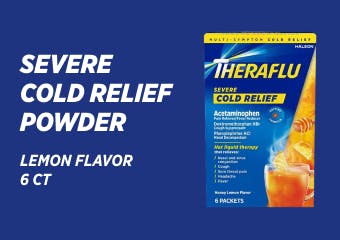What Causes a Head Cold?
There are over 200 different viruses that can be responsible for the common cold, but in most cases a cold is the result of a group of viruses called rhinoviruses. When this virus gets into our bodies, it sets off an immune symptom reaction that causes cold symptoms.3,4,5
Every year, millions of Americans get colds from viruses. Adults experience two to three colds annually on average, while children may get over eight per year.2,4 Children have less developed immune systems than adults, and that makes them more likely to contract a cold.8
What are the Symptoms of a Head Cold?
Symptoms may vary from person to person, but typical common cold symptoms include:
- Stuffy nose
- Sneezing
- Sore throat
- Cough (‘hacking’, brings up mucus)
- Headaches (sometimes)
- Mild to moderate chest congestion
- Slight body aches
- Mild fatigue
How are Head Colds Spread?
Head colds are caused by a virus entering the body, which can happen either through the air or through direct contact with the virus – so unfortunately, it’s quite easy for them to spread.3
Viruses can be transmitted via water droplets in the air from an infected person’s cough or sneeze, which are then inhaled by you. You can also come into contact with the virus by touching an infected surface (such as doorknobs, rails or other objects), or by close direct contact with someone who has the virus (shaking hands, hugging or kissing). If you picked up a virus from an infected surface or person, then touch your mouth, eyes or nose, you may become infected too.1,3
You’re more likely to come down with the symptoms of a head cold in the winter or fall, but you can get them at any time.1
What are the Treatments for a Head Cold?
Unfortunately, there’s no cure for a head cold – and antibiotics won’t make it go away. While you’ll usually feel better within 7-10 days, there are some ways you can treat your symptoms and get some relief while you recover:1,6
- Rest: This will give your body the best chance to recover. Stay home from work or school whenever possible.
- Drink plenty of fluids: Keep hydrated by drinking lots of water, tea or juice throughout the day. Avoid caffeinated and alcoholic beverages, which may dehydrate you.
- Increase air humidity: Using a humidifier can help to ease congestion and coughing. If you don’t have a humidifier, try having a hot shower or bath to breathe in the steam.
- Gargle salt water: If you’re suffering with a sore or scratchy throat because of your head cold, try dissolving 1/4 to 1/2 teaspoon salt in a glass of warm water for temporary pain relief. Simply gargle the mixture and then spit out.
- Try over-the-counter medications: OTC cold medicines such as Theraflu ExpressMax Severe Cold and Flu Syrup or Theraflu Multi-Symptom Hot Liquid Powder can help to provide temporary relief from your cold symptoms.
Next Steps
If you're suffering from head cold symptoms, discover our wide range of Theraflu products that are formulated to provide you with relief.
When to see Your Doctor
If your symptoms persist or get more severe, you might need to seek medical attention. You should visit your doctor or go to an emergency room if you’re an adult and:
- You have a fever higher than 101.3 degrees Fahrenheit2
- Your fever lasts longer than 4 days7
- Your fever suddenly returns
- You’re having trouble breathing
- Your sore throat, sinuses, or headache become more severe2
You should take your child to the doctor or emergency room if they have:
- A fever higher than 100.4 degrees Fahrenheit2
- A fever that lasts longer than 2 days
- Symptoms that become more severe
- Dehydration7
- Trouble breathing (wheezing or rapid pace)8
- Lips that look blue8
- Vomiting8
- Severe drowsiness
- Ear pain
- Pus draining from the ear8
- Lack of appetite2
Some rare symptoms your child might experience that could warrant a visit to the doctor or emergency room are:8
- Signs of an eye infection like one or both eyes shut with dried pus
- Exhaustion
- An unusual change in behaviour
- Thick discharge coming from the nose
- Yellow or green discharge coming from the nose8
There are other possible, but rare, symptoms that could cause you or your child to have to go to the doctor as well. If you experience rare or severe symptoms, seek immediate medical attention.





